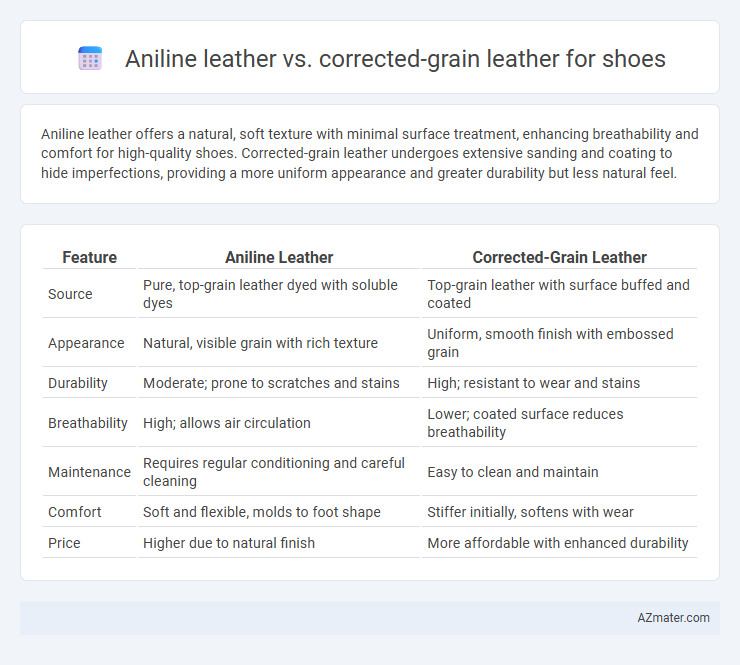Aniline leather offers a natural, soft texture with minimal surface treatment, enhancing breathability and comfort for high-quality shoes. Corrected-grain leather undergoes extensive sanding and coating to hide imperfections, providing a more uniform appearance and greater durability but less natural feel.
Table of Comparison
| Feature | Aniline Leather | Corrected-Grain Leather |
|---|---|---|
| Source | Pure, top-grain leather dyed with soluble dyes | Top-grain leather with surface buffed and coated |
| Appearance | Natural, visible grain with rich texture | Uniform, smooth finish with embossed grain |
| Durability | Moderate; prone to scratches and stains | High; resistant to wear and stains |
| Breathability | High; allows air circulation | Lower; coated surface reduces breathability |
| Maintenance | Requires regular conditioning and careful cleaning | Easy to clean and maintain |
| Comfort | Soft and flexible, molds to foot shape | Stiffer initially, softens with wear |
| Price | Higher due to natural finish | More affordable with enhanced durability |
Introduction to Aniline and Corrected-Grain Leather
Aniline leather features a natural finish with minimal processing, preserving the hide's original texture and markings, which enhances breathability and comfort in shoes. Corrected-grain leather undergoes surface sanding and pigment application to mask imperfections, providing a uniform appearance and increased durability ideal for frequent wear. Both types offer distinct aesthetic and functional qualities, with aniline leather prized for its softness and natural look, while corrected-grain leather emphasizes consistency and resistance to blemishes.
What is Aniline Leather?
Aniline leather is a type of high-quality leather that is dyed using soluble dyes without covering the surface with a topcoat or pigment, preserving its natural texture and markings. This results in a soft, breathable, and supple material often prized for its rich, natural appearance and durability. Compared to corrected-grain leather, which undergoes surface sanding and pigmentation to cover imperfections, aniline leather offers superior aesthetics but may require more care to maintain its pristine condition in shoes.
What is Corrected-Grain Leather?
Corrected-grain leather is manufactured by sanding the hide's surface to remove imperfections, followed by embossing with an artificial grain pattern and coating with pigments and sealants for durability. Unlike aniline leather, which retains the natural surface and breathability, corrected-grain leather offers increased resistance to stains, scratches, and fading, making it a practical choice for shoes used in harsher conditions. This type of leather balances aesthetic appeal and longevity by masking flaws without compromising structural strength.
Appearance and Aesthetic Differences
Aniline leather offers a natural, rich appearance with visible grain patterns and unique markings, providing a soft, luxurious finish favored for high-end shoes. Corrected-grain leather has a more uniform surface achieved through sanding and embossing, resulting in a consistent texture ideal for durable footwear with a polished look. The distinct difference lies in aniline's organic aesthetic versus corrected-grain's refined, manufactured appearance.
Durability and Wear Performance
Aniline leather offers a natural, soft finish with excellent breathability but is more prone to scratches and stains, making it less durable for high-wear shoes. Corrected-grain leather undergoes surface sanding and coating, providing enhanced resistance to abrasion and water, which significantly improves its wear performance in daily use. For footwear subjected to frequent wear and rough conditions, corrected-grain leather is typically the preferred choice due to its superior durability and ease of maintenance.
Comfort and Breathability Comparison
Aniline leather offers superior comfort and breathability for shoes due to its minimal surface coating, allowing natural pores to remain open and facilitating better air circulation. Corrected-grain leather, treated with heavier coatings to mask imperfections, tends to be less breathable and can feel stiffer, reducing overall comfort during extended wear. Therefore, aniline leather is preferred for shoes where flexibility and moisture-wicking properties are critical to foot comfort.
Maintenance and Cleaning Requirements
Aniline leather demands gentle care with regular use of pH-balanced cleaners and conditioners to maintain its natural look and softness, avoiding harsh chemicals or excessive moisture that can damage its surface. Corrected-grain leather features a protective topcoat that makes it more resistant to stains and easier to clean with mild soaps or leather wipes, requiring less frequent conditioning. Both types benefit from avoiding prolonged exposure to water and direct sunlight to prevent fading and cracking, but aniline leather generally requires more attentive maintenance to preserve its premium appearance.
Cost and Value Analysis
Aniline leather offers a premium, natural appearance with minimal surface protection, resulting in a higher cost due to its quality and limited finishing processes. Corrected-grain leather is more affordable, featuring a sanded and embossed surface that masks imperfections and provides enhanced durability, making it a cost-effective choice for shoes requiring long-lasting wear. While aniline leather delivers superior aesthetics and softness, corrected-grain leather provides better value for budget-conscious buyers prioritizing resilience and ease of maintenance.
Best Uses for Shoe Applications
Aniline leather offers a natural, breathable surface with minimal processing, making it ideal for high-end dress shoes where softness and unique patina are desired. Corrected-grain leather, treated with a surface coating to mask imperfections, provides enhanced durability and stain resistance, suited for everyday shoes and work boots requiring rugged performance. Choosing between the two depends on balancing the need for luxury appearance against practical wear and maintenance considerations in footwear.
Choosing the Right Leather for Your Shoes
Aniline leather offers a natural look and soft feel with minimal finishing, showcasing the hide's character but requiring more care and susceptibility to stains and scratches. Corrected-grain leather undergoes surface sanding and pigment application, providing enhanced durability, uniform appearance, and resistance to wear, making it a practical choice for everyday shoes. When choosing leather for shoes, balance aesthetic preference with maintenance willingness and usage frequency to select between the luxurious yet delicate aniline leather and the sturdy, low-maintenance corrected-grain option.

Infographic: Aniline leather vs Corrected-grain leather for Shoe
 azmater.com
azmater.com